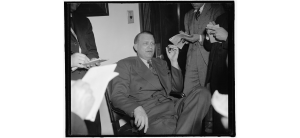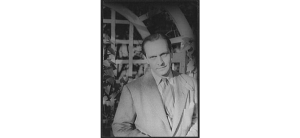
The Cold War & Internal Security Collection and Joyner Library Special Collections are hosting a joint exhibit titled “HUAC Goes to Hollywood: Aspects of the Blacklist 70 Years Later.” The exhibit can be found on the first floor of Joyner Library, and will remain up through the end of December. This is the first of four CWIS blog posts that will expand on this exhibit.
The House Un-American Activities Committee (HUAC) launched three major investigations of communist influence in the motion picture industry. The most famous HUAC hearings regarding the film industry were the Hollywood Ten hearings of October 1947. In addition to numerous “friendly” witnesses such as Ronald Reagan, Gary Cooper, and Ayn Rand, HUAC subpoenaed 19 “unfriendly” witnesses believed to be tied to the Communist Party (CPUSA). Eleven testified before HUAC; ten openly defied the committee, and were eventually sentenced to up to a year in prison for contempt of Congress. These “Unfriendly Ten” eventually became known as the Hollywood Ten. In November 1947, the heads of the major Hollywood studios issued a statement that they would no longer employ the Ten, nor anyone else known to be a communist. This was the birth of the blacklist.
HUAC’s final investigation of Hollywood occurred in 1951-52. By far the most extensive, this set of hearings featured nearly 100 witnesses. Those considered to be friendly witnesses “named names” of others they knew were part of the CPUSA; unfriendly witnesses pleaded the Fifth Amendment to avoid incriminating themselves and others.
The first investigation was the shortest, lasting only four days in the summer of 1940, and mostly being conducted behind closed doors. It remains little remembered today. It set the precedent, however, that the political leanings of Hollywood were a valid topic of congressional investigation, and paved the way for the far more extensive hearings of 1947 and 1951-52. The HUAC Hollywood investigation of 1940 was the first step on the road to the blacklist.

The Dies “Subcommittee” Goes to California:
On July 17, 1940, Representative Martin Dies, Jr. (D-TX), chair of the House Special Committee on Un-American Activities, was taking testimony in Beaumont TX. as a one-man subcommittee. Among the witnesses was a man named John L. Leech. A former Communist party (CPUSA) official in the Los Angeles area, Leech testified that 42 individuals involved in the motion picture industry were members of the CPUSA. Among the individuals he named was Fredric March, an Academy Award winner who was one of the major stars of the day. In a follow-up appearance before Dies on July 19, he named iconic actor James Cagney as another CPUSA member.
While Leech’s testimony was taken in executive session, meaning that it was behind closed doors, Dies released a summary that included Leech’s broad claims about CPUSA influence in Hollywood, but without naming those implicated by Leech. However, many of the names were soon released by a Los Angeles grand jury that Leech also testified before. Having generated the press headlines he was seeking, Dies headed to California the next month to question some of the film industry personalities named by Leech.
Dies held four days of closed hearings in California: August 16-17 in Los Angeles, and August 19-20 in San Francisco. Again serving as a one-man subcommittee, Dies took testimony from a number of people associated with Hollywood, including Humphrey Bogart, Cagney, March, and screenwriter Philip Dunne. All denied being members or supporters of the CPUSA. Dies found their testimony convincing. Most of Leech’s charges, in HUAC historian Walter Goodman’s words, “dribbled away like sand.” As soon as the hearings were over, Dies released a statement on August 20 absolving Bogart, March, Cagney, and Dunne of any ties to communism.
In the opinion of most writers, Dies’ main goal in going to Hollywood seems to have been to generate publicity for himself and his committee. The Dies investigation itself had little impact on CPUSA efforts in Hollywood, or film industry political activism in general. The precedent Dies set, however, would have a far reaching impact. Just seven years later would come the infamous Hollywood Ten hearings, followed by the promulgation of the blacklist.
CWIS Sources on the 1940 Hearings:
Investigation of Un-American Propaganda Activities in the United States, Hearings before a Special Committee on Un-American Activities, House of Representatives, Seventy-Sixth Congress, Third Session. Volume 2, Executive Hearings. 1941. (Joyner Docs CWIS: Y 4.Un 1/2:Un 1/3/V. 2)
-The official transcript of John L. Leech’s initial testimony regarding communist influence in Hollywood, from pages 961-970, and 974-981.
Investigation of Un-American Propaganda Activities in the United States, Hearings before a Special Committee on Un-American Activities, House of Representatives, Seventy-Sixth Congress, Third Session. Volume 3, Executive Hearings. 1943. (Joyner Docs CWIS: Y 4.Un 1/2:Un 1/3/V. 3)
-Features the official testimony of Bogart, Cagney, March, and others before the Dies subcommittee in August 1940. Leech’s accusations against Cagney are on pages 1123-1124.
CWIS Sources on the Other HUAC Hollywood Hearings:
Communist Infiltration of the Motion Picture Industry – Hearings before the Committee on Un-American Activities, House of Representatives, Eighty-Second Congress, First (Second) Session. 1951-52, 10 v. (Joyner Docs CWIS: Y 4.Un 1/2:C 73/21)
-Transcript of the most extensive HUAC investigation of Hollywood, featuring dozens of motion picture industry witnesses, both “friendly” and “unfriendly.”
Hearings Regarding the Communist Infiltration of the Motion Picture Industry, Hearings before the Committee on Un-American Activities, House of Representatives, Eightieth Congress, First Session. 1947. (Joyner Docs CWIS: Y 4.Un 1/2:C 73/3)
-The official transcript of the 1947 Hollywood Ten hearings.
Other Sources:
Billingsley, Kenneth Lloyd. Hollywood Party: How Communism Seduced the American Film Industry in the 1930s and 1940s. Rocklin, CA: Prima Publishing, 1998. (Joyner Stacks: PN1998.2 .B53 2000)
Dunne, Philip. Take Two: A Life in Movies and Politics. New York: McGraw Hill, 1980. (Joyner Stacks: PN1998.A3 D85)
Goodman, Walter. The Committee: The Extraordinary Career of the House Committee on Un-American Activities. New York: Farrar, Straus, and Giroux, 1968. (Joyner Stacks: E743.5 .G64)
Radosh, Ronald, and Allis Radosh. Red Star Over Hollywood: The Film Colony’s Long Romance with the Left. San Francisco: Encounter Books, 2005. (Joyner Stacks: PN1998.2 .R33 2006)